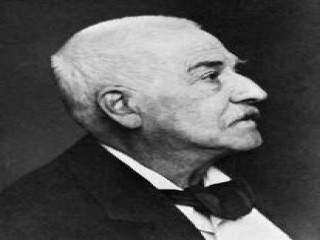
Jacob Burckhardt biography
Date of birth : 1818-05-25
Date of death : 1897-08-08
Birthplace : Basel, Switzerland
Nationality : Swiss
Category : Historian personalities
Last modified : 2011-07-04
Credited as : Art and culture historian, ,
Through the use of eyewitness accounts, diplomatic documents, and the contents of government archives, the teachers and contemporaries of Jacob Christoph Burckhardt sought to reconstruct political events "as they had really happened." Burckhardt, however, viewed history as the record of the achievement of the human spirit. Politics was only part of that record. The highest expression of any age was to be found in its poetry, art, literature, and philosophy. The historian's task was to seek the spirit these works expressed, so the reader might be "not smarter for the next time but wiser forever."
Burckhardt was born in Basel on May 25, 1818. His father, a pastor at the Basel Minster, was elected administrative head of the Reformed Church in the canton in 1838. The year before, Jacob had begun theological studies at the University of Basel. Within 18 months, however, he lost his orthodox religious beliefs and turned from theology to history. He studied in Berlin for 4 years, attending the lectures of Johann Droysen, August Boeckh, and Franz Kugler, and Leopold von Ranke's seminar. Burckhardt formed close friendships with a group of poets and students of revolutionary liberal political views.
In 1843 Burckhardt returned to Basel, where he took a post as political correspondent with the conservative Basler Zeitung, and lectured at the university on art history. He immersed himself in the political crisis then shaking Switzerland, a crisis brought on by the return of the Jesuits to the Catholic canton of Lucerne. Then in 1846, disgusted by what he had seen, he left for Italy. His political views had turned to cultural and aristocratic conservatism. During the next 12 years he taught and wrote in Berlin, Basel, and Zurich, with lengthy trips to Italy in 1847, 1848, and again in 1853 to prepare the Cicerone.
During the winter of 1847-1848 Burckhardt planned a series of cultural histories, beginning with the age of Pericles and ending with the age of Raphael. The first to appear was The Age of Constantine the Great (1852). The structure of this work was one that Burckhardt would use again in his later cultural histories and analyze in detail in his Reflections on World History: the "three great powers"—state, religion, and culture—and the ways in which they determine each other. The book is thus concerned as much with art and literature as with politics and religion.
Burckhardt's Cicerone (1854) was "a guide for the enjoyment of art in Italy." In form a traveler's guidebook, it was in reality a history of Italian art. In it Burckhardt first tried to solve the problem of systematic art history, tried, as he later put it, to get away from "the mess of art history as the history of artists," to go beyond biography to the analysis of historical and geographical styles.
While still a student in Berlin, Burckhardt had come to the conclusion that the French Revolution had "pulled the historical ground from under the feet" of all European peoples. Just as in art the styles of every age now coexisted, "one beside the other," with no single tradition dominating, so with the state "the nineteenth century began with a clean slate." The individual now had free choice in politics, and nothing to fall back on but his own "inner truth." The application of this insight to the culture of Renaissance Italy resulted in Burckhardt's masterpiece, The Civilization of the Renaissance in Italy (1860).
In this work Burckhardt proposed that the conflict between popes and emperors had deprived 13th-century Italy of legitimate political rule, had left it with that "clean slate" he saw in his own times. This climate allowed political units to appear "whose existence was founded simply on their power to maintain it." But it also freed the individual of all traditional constraints, whether political, religious, or social. Expressed through artistic and literary forms revived from antiquity, this freed and self-conscious individualism, this "genius of the Italian people … achieved the conquest of the western world." In the Italian Renaissance, Burckhardt saw the major characteristics of the modern world, its evil as well as its good.
Burckhardt explained his thesis in his lectures of 1868-1869, "On the Study of History," in the course of a wide-ranging analysis of the "three powers" at the heart of his historical vision. Culture, in contrast to the constants, state and religion, "is the sum of those spiritual developments that appear spontaneously." Its form and its vehicle are the product of societies and epochs, but its source is always the individual. To study culture is thus to study the individual giving expression to his place and his age as well as himself.
After publishing his notes on Italian architecture in 1867, Burckhardt prepared nothing more for the press but devoted himself until his retirement in 1893 to lecturing at the university. His series of cultural histories was never completed, but his lectures covered the entire sweep of European history from the ancient Greeks to the European crisis of 1870. In an age of ever-narrower nationalisms, Burckhardt reached back to the universal humanism of Goethe.
After 1870 Burckhardt became increasingly pessimistic about the future of European culture. Though he hoped for another Renaissance, he feared the arrival of the "fearful simplifiers," the demogogues who would lead the "masses" to tyranny and destroy the European culture he loved. "The world is moving toward the alternative of complete democracy or absolute, ruthless despotism," he wrote to a friend in 1882. The day would come when "the military state will turn industrialist." He withdrew to two sparsely furnished rooms above a bakery shop and devoted himself to his work on Italian art, which he never completed. He died on Aug. 8, 1897.
















